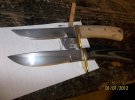- Joined
- Jul 8, 2008
- Messages
- 1,079
hey guys, I was soldering a guard the other day, and just when the solder started to flow, the blade just ahead of the guard started discoloring from the heat so I had to refinish the blade afterwards with the guard on.
in one of the threads below, there is a guy who just uses jb-weld. does jb weld seal up the guard so moisture dosent penetrate it? does it last like solder will?
anyone ever had problems with using jb-weld for that?
Joe
in one of the threads below, there is a guy who just uses jb-weld. does jb weld seal up the guard so moisture dosent penetrate it? does it last like solder will?
anyone ever had problems with using jb-weld for that?
Joe

